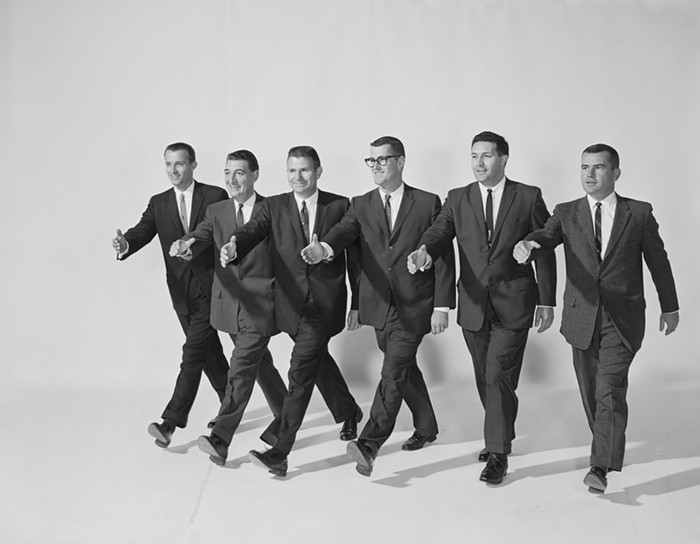IT'S 10 PM ON CINCO DE MAYO, and I'm standing on the porch of Charles Wittenmeier's home in Mount Tabor. In the side yard, a stick figure made from the limbs of a fallen tree stands on a tidy bed of flower petals. The house recedes down a hill, and trees, bushes, and wooden gates block visibility from traffic and surrounding houses. Intricate, overgrown paths wind around the back of the property.
As I open the front door, a jam session bleeds out to the porch. Inside, musicians improvise around a cube of organs, and I crack a beer and walk through a busy kitchen. Nobody seems to notice as I find the stairs to the basement. The stairs lead to a corridor and I walk down it, passing a storage room on the left and a production room on the right, then a bathroom and two bedrooms—one occupied by Wampire's Rocky Tinder; the other by a guy sleeping on the floor while television-light flickers across him.
I make my way back upstairs and then to the top floor, finding another cluster of rooms. A girl with a psychedelic light-up pom-pom pops from a bathroom. Her name is Amanda, and she just got here too. A guy named Dave exits after her. We all explore rooms, finding the last evidences of a family presence—small toys and scant furniture. I'm told that I just missed O Bruxo's set, and that Jizz Wisard's was postponed because the cops came.
This is the set of Jordan Kinley's latest production, 28 Days in May, a documentary of the 28 days before Wittenmeier's mansion goes into foreclosure. In its final month, artists and musicians have been invited to use Wittenmeier's home as a place to create and collaborate. Throughout May, bands are playing and recording, and Chris Haberman is bringing in visual artists. Wittenmeier, himself a commercial director, asked Kinley to produce the film, and Kinley brought on the Into the Woods production crew to make the rest happen. (Led by the 23-year-old producer, the Into the Woods series is known for making videos of local bands playing in "intimate" contexts—think Take Away Shows, though Portland-focused.)
The clock strikes 11 pm and everyone is ushered out, bringing the first 28 Days in May open house to a close. In the morning the mansion will briefly return to its domestic value when Wittenmeier's soon-to-be ex-wife comes to remove personal belongings. As we're leaving, I hear voices from the kitchen coursing through delayed-out speakers in the upstairs hallway—later I'm told that Joe Plummer, of Modest Mouse and the Shins, created this installation. We all go our separate ways.
You've definitely seen Wittenmeier's commercial work: He did a Budweiser ad where a guy opens and pours a beer using telekinesis; another where God spills Tabasco meteorites on the earth; more where kids set up restaurant-scale lemonade stands on front lawns. Into the Woods is less widely known—it's a web series that focuses on Portland music and the lifestyle that surrounds it. The first episode took a trip to a cabin in Government Camp, Oregon, where Wampire played for a roomful of friends. It shuffles footage of the band gearing up for the trip, buying groceries, driving, settling into the cabin, cooking, partying—Wampire's performance is the soundtrack throughout, framing the domestic and social elements.
In early April, when Wittenmeier decided to open his house to musicians and artists, Into the Woods had run out of money to create new episodes, and was lying dormant. Wittenmeier called Kinley and explained the idea to open up his mansion to musicians and artists—to create a film about the foreclosure of his home, documenting a celebration of loss. Kinley, who began assisting Wittenmeier on commercial projects several years ago, only agreed after he'd recruited most of the Into the Woods team. There is virtually no budget for the film, and it only stays afloat as people work for free and guests contribute what they can.
As a production team, Into the Woods has always been decidedly recession-era, generating strong content with few resources beyond the means of production (they all own cameras and sound gear). In this tradition of making something from what's at hand, a record from the age of the sub-prime American dream is being captured. Moreover, Wittenmeier's fading mansion operates as a symbol of our long economic decline: The return for the team's unpaid work is not only getting in on a fun project, but also producing something that they feel is a worthwhile document of the times.
After several days on and off the 28 Days in May set, I've seen a near-constant stream of music being recorded, performed, and written. A joke butt-rock band forms, records one song—which was a total rager—and "breaks up." My personal highlight was Travis Wiggins singing and rhyming over some sample-based tracks (think chillwave Nintendos vs. indie soul-funk) on a balcony while the sun sets into the clouds. At 3 am one night, I fell into a collaboration, reading poems from my upcoming book as Wampire's Rocky Tinder played a Fun Machine organ as a backdrop. The Great Mundane thumped through some experiments and collabs, while members of Archers worked on new material on the porch. Ghosties (the solo project of Typhoon's Devin Gallagher) recorded some tracks. Fabi Reyna melted acoustic hearts. Other musicians slated to perform or record include Dragging an Ox Through Water, Explode into Colors, Au, White Fang, Starfucker, Y La Bamba, Typhoon, the Woolen Men, Ethan Rose, and many more.
In addition to the music, various art projects are in planning and build-out stages. Lea "Luna" Littleleaf is working from a welding tent she's erected in the side yard. She's making the frame for a wooden egg that will act as a kiosk to create, arrange, and combine sound and user-generated text. Naked dready girls do bizarre performance art in a bubble bath. Gabe Flores scouts the space for a collaboration with Gary Wiseman. Damien Gilley is coming to make his signature perspectival line drawings, though they'll be contained to windows. I spoke with Jason Traeger from London where Oregon Painting Society is installing at the Tate Modern, and he said they plan on coming by after they get back into town on May 20. JShea9 plans to install sculptures around the property. Future Death Toll and the Appendix Project Space crew confirmed that they plan on contributing. New projects spring up hourly and planned ones are slowly taking shape.
Throughout all of it, I've spoken with Wittenmeier a handful of times, though always briefly and with understandable interruptions (between his kids and his house, there's a lot to manage). On May 11, he requests a meeting with Kinley and myself.
"Where are we going?" I ask, as Kinley drives us to meet Wittenmeier.
"Charles' kids' school," he answers.
We pull up just as Wittenmeier parks his van. Kinley immediately points the camera at him, and Wittenmeier clams up into a skeptical half-smile. The three of us walk to the blacktop, where the kids are out for recess. We sit and chat as Wittenmeier's son occasionally comes up to get help adjusting the height of the handlebars on his scooter. These brief interactions with his family seem to make him more at ease when talking on camera.
Wittenmeier talks about losing his house as a story with gain under the surface—he'll be cleared of a home that costs $100,000 per year, one that requires working unattractive commercial gigs. He's now a renter again after several decades. With reduced living costs, he'll actualize dreams like 28 Days in May. It's an upside to the downturn, and I've noticed this trend in circles of out-of-work creatives around town. Finding opportunity inside a lemon—there's a lot of that going on around Wittenmeier's house.
But why open up his home to artists? Wittenmeier is interested in documenting the times, in capturing creativity circa the Great Recession. The previous day, he told me that when Explode into Colors played his birthday party at the house last year, it just felt right to have bands in the space. As an extension of that indie/mansion juxtaposition, 28 Days in May is an experiment to see what happens when people who are surrounded by joblessness and lack of opportunity are given a chance to create, collaborate, and feel like they're being heard. Plus, Wittenmeier's always wanted to use his house—which he refers to as "a piece of art"—as the set for a film. The opportunity is now.
The mansion is tooled to capture everything. Cameras are constantly rolling at Wittenmeier's place. Artists and musicians will continue working through May 28. It's hard to say what the place will end up looking like in the last hours, or whether the general public will be invited to see the results of the month-long creative sprawl in person—stay tuned on Blogtown (blogtown.portlandmercury.com), and check 28daysinmay.com for updates on the possibility of a public opening.
Wittenmeier focuses on facilitating the creativity that surrounds him, busily talking with Kinley about who is booked and what's happening next. It's a sign of the paradigm shift inspired by recession, where impossible materialism (a craze which Wittenmeier contributed to via his commercials) is curbed in favor of the narrative of the moment—simply embracing what's around.
28 Days in May is the evidence, even in its infant stages.













